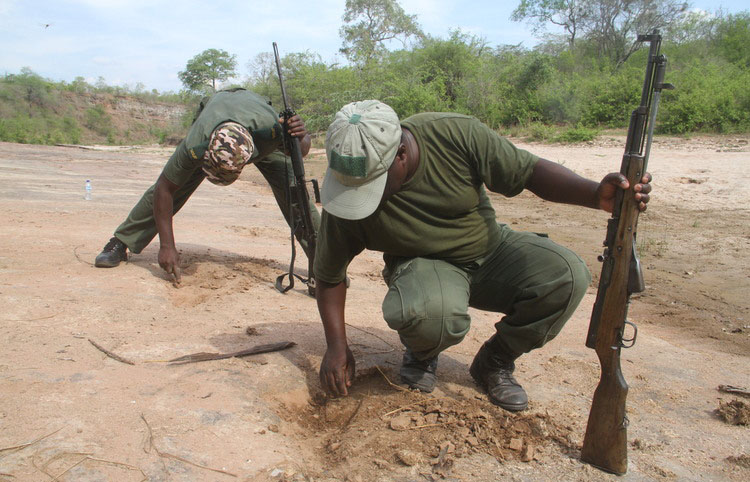
The Sunday Mail

To the outdoors enthusiast, the Zambezi Escarpment is the ultimate destination: home to the Big Five, bed to the fourth-longest river on the continent, host to one of the Seven Wonders of the World, and teeming with flora.
For an escarpment that stretches an approximate 800km, it is not surprising that it also holds the answers to some questions about the world’s history, palaentology and geology.
Popular with hunters it should also be of little surprise that it was a hunter, Australian Mike Aldersey, who stumbled upon dinosaur footprints here in 1984.
Before this discovery, Africa had helped solved a lot of palaentological mysteries, particularly via discoveries of fossilised dinosaur skeletons in East Africa.
Significantly, as much as dinosaur fossils had been unearthed in Africa, no footprints had been discovered, which made the Ntube discovery all the more historic.
The Ntube River might not be too familiar a name, but it is here that pre-historic dinosaur footprints of the theropod species were discovered in 1984.
The Fossil Forest lies a dinosaur’s spitting distance from the footprints.
 After the rains, the spoors are filled with soil such that only those who know where they are, are able to locate them
After the rains, the spoors are filled with soil such that only those who know where they are, are able to locate themHardly navigable in the wet season, the best time to visit Chewore Safari, home to Ntube River and the Fossil Forest, is the hot season – a time when temperatures are typically above 30 degrees Celsius.
Roughly 20km after Mushumbi Pools is the Fossil Forest, where petrified wood can be found. Protected by the Museums and Monuments Act, the petrified wood lies close to the road.
According to ZimFieldGuide.com, the petrified wood comes from the Triassic age when the original wood in tree trunks, the organic part, was replaced by minerals, mainly silica.
The guide states that the original trees were probably part of the gymnosperms species, a group of seed-producing plants that includes conifers, cycads, Ginkgo and Gnetales and most probably huge ferns.
“Vast swamp areas during the Triassic period, about 200 million years ago, were overlaid in coarse sandstones with mudstones, within a 100 years the organic materials, being the carbon in the wood, would have been replaced by quartz silica, with traces of copper and iron oxides. In this state it is known as petrified wood.”
For wood to petrify, rare conditions must exist: the fallen plants get buried in an environment free of oxygen (anaerobic environment), which preserves the original plant structure and general appearance. Other conditions include regular access to mineral-rich water in contact with the tissues, replacing the organic plant structure with inorganic minerals.
The end result is petrified wood, a plant, with its original basic structure replaced by stone.
Manganese, iron, copper and chrome elements in the water have gradually deposited in the plant cells and stained the stone in their black, red, brown, yellow and green colours.
On some of the logs of petrified wood is preserved the original structure of the stem in all its detail, down to the microscopic level with the original tree rings and the various plant structures may still be observed.
But this is but just a minor diversion, the purpose of our tour was to get to the dinosaur spoor, about 70km away – which in the dinosaur world is a short walk.
After stumbling across the footprints, Aldersey notified the world and palaentologists and archaeologists took notice.
The Zimbabwe Geological Survey team dispatched the husband and wife team of Tim and Patricia Broderick to investigate. Before long, Zimbabwe was on the world map, palaeontology-wise.
A new chapter had been added to palaentology in general but Chewore Safari gained a spike in interest: it was no longer just a hunting destination.
Writing for The Guardian, palaentologist Theagarten Lingham-Soliar, who went with the gound-breaking expedition with the Brodericks, explained: “A hunter stumbled upon a track-way in the rock of 14 footprints belonging to a large, carnivorous dinosaur which roamed the region 140 million years ago and left its tracks deep in muddy terrain.
“The footprints dried rapidly in the hot Jurassic sun and with a-million-to-one odds became sandstone rock with the passing of geological time.”
Presently, the spoor has fallen foul to weathering and erosion.
Tinashe Farawo, spokesperson for the Zimbabwe Parks and Wildlife Management Authority, said: “Zimbabwe is a very diverse and nature-gifted country. The Zambezi Escarpment offers much more than just the wildlife, we have a lot of history preserved in our resorts. So when tourists and hunters visit, they should look out for much more than the wildlife.”



